In search of the perfect fork blade
 Mon, December 10, 2007
Mon, December 10, 2007 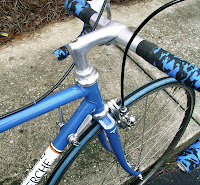
When a fork blade comes from the tube manufacturer’s factory, it is straight; the framebuilder bends it to a curve that suits his requirements.
An un-raked road fork blade is oval at the top; the oval section runs parallel for about a third of its length. Then the cross section becomes round and starts to taper gradually to its smallest section at the bottom end.
The fork blade is bent on a curved form that is sometimes made from hard wood. I used one I made myself from two heavy-duty steel fork blades, bent in the desired curve, and brazed together side by side. This made a natural grove between the two blades where the blade would sit as I was bending.
I would slip a short piece of tube over the thin end of the form and the blade I was bending to hold it in place. Then start bending, first by pushing down by hand. The thin end of the blade bends easily, and I would finish off by squeezing it in a vise.
Bicycle tubing is hardened, and it will spring back after bending. Because of this, the form needs to be a greater curve than the finished fork blade will be.
A fork blade is several inches longer than it needs to be. The framebuilder chooses where he will put the bend, and where he will cut to length. For example, if I were making a criterium frame and wanted a very stiff fork, I would cut from the bottom, thin end.
If I were building a touring frame, and wanted a flexible fork for a more comfortable ride, I would cut from the top end and leave the blade thin at the bottom end. The framebuilder creates the perfect fork blade, by selecting the best place to bend the blade, and by choosing how much to cut from either end.
It is rather like a furniture maker choosing where to cut from a piece of wood to achieve the best end product. Once I arrived at the perfect fork blade, it was then an easy matter to repeat the process again and again.
On a John Howard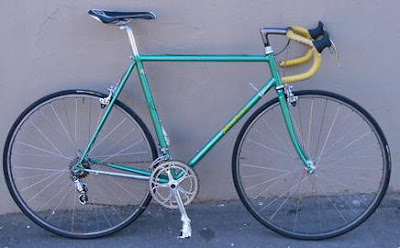 On a Fuso
On a Fuso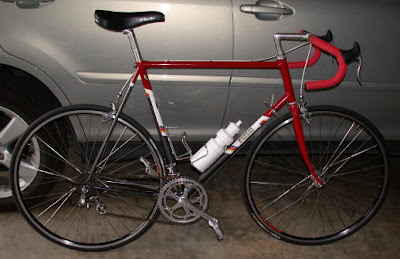 And on a Recherche
And on a Recherche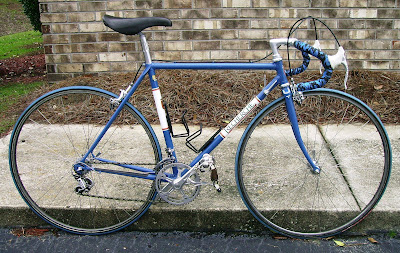 One exception to this process was the Reynolds 753 fork blades. 753 was heat treated to a degree that the material could not be bent after. These were bent at the factory, then heat treated, and the framebuilder then cut to the required length. You will notice on the 753 Fuso Lux frame (Pictured below.) that the fork bend is a different shape than the ones bent by me. More pictures of this bike can be seen here.
One exception to this process was the Reynolds 753 fork blades. 753 was heat treated to a degree that the material could not be bent after. These were bent at the factory, then heat treated, and the framebuilder then cut to the required length. You will notice on the 753 Fuso Lux frame (Pictured below.) that the fork bend is a different shape than the ones bent by me. More pictures of this bike can be seen here.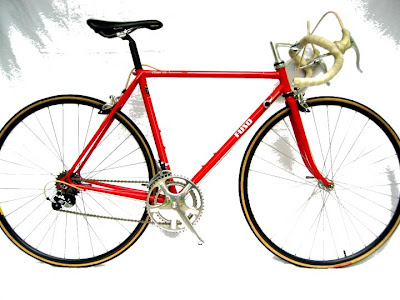 Chainstays and seatstays are also tapered and the same selective cutting to length is employed. In this case, where the cut is made depends a great deal on the size of frame and its end use.
Chainstays and seatstays are also tapered and the same selective cutting to length is employed. In this case, where the cut is made depends a great deal on the size of frame and its end use.
The perfect fork blade is stiff enough to allow precise handling, but with some flex to absorb road shocks. It also looks pleasing to the eye. I have a theory that when something is designed correctly from a functional standpoint, it has a natural aesthetic beauty. This is true of a boat, a bridge, a building, and even a bicycle frame.
The modern trend of building straight forks of course saves the framebuilder a great deal of time and effort. If this look has become acceptable, why should today’s builder go through all the time consuming process I have described here?
The straight blade is angled forward so the same fork rake or offset is achieved and handling would be the same. I can’t comment on the shock absorption qualities because I have never built a frame with a straight fork.
In my view, a great deal is lost aesthetically, so where does that leave my theory about function being linked to aesthetics? On the other hand, is it simply that beauty is in the eye of the beholder?
 Dave Moulton | Comments Off |
Dave Moulton | Comments Off | 

















Reader Comments (12)
For example the Open 60 class boats.
Really like the drivetrain, frame, and wheel choices on that one.
About aesthetics following from function: when you (Dave) are designing and building a bike, are you sure that there's not something hidden in the back of your mind that makes you to make it look good to you? That is, you might add something to the function (objective/criteria) of the bike (it rides and it has to look good to me).
And aren't those marvellous engineers not making sure that it looks exactly as specified by some other marvellous engineers. Like marketing said that we need to have these crazy-curvy forks that those Italians thought of because their asian supplier bought some overpriced machine that could mold rakes with more than one bend, and double-curves surfaces are every mechanical engineer's wet dream?
It's a pity that most engineering studies are not that broadly oriented. This here engineer's mother fortunately holds a teaching degree in art, hence my fondness of the esthetecyclist http://esthetecyclist.blogspot.com/
A perfect explaination as to why I never bothered replacing the fork on my Recherche with Carbon. Even if I would save some weight, the price paid for change in handling could never be worth it. People designing today's bikes, using stock forks are missing out on half the equasion IMO.
Bob J
Check out the Europeans. Their bicycle designs, or any design for that matter, is simply awesome. They put a lot of time into it (although they don't have it right all the way)
I believe any engineering design should revolve around the aesthetic and emotional values of the end user in mind. This aesthetic portion should be incorporated into the creative design process. This is what hundreds of schools and colleges across the country are lacking out, I believe.
Hopefully the technology of tomorrow won't leave out the emotional aspects tied in with right hand portion of the brain out.
The Bates fork shown here recently also looks a little "odd", but not in a bad way. It looks distinctive (but I doubt if it gave a softer ride; I'd guess harder, if anything). At least it wasn't ugly.
A bicycle needs to have a certain "qi" to it. (Qi is the Chinese feng shui term, pronounced "chee", meaning energy flow)... Sometimes it may be unseen, and only felt in the ride characteristics... Other times this qi is clearly visible... what I prefer to call "mechanical beauty"...
A well-designed steel fork, with the right curve, matched with the right frame... can have an extraordinary chi. I'm sure you've rolled on a bike that has that indescribable quality...
Nice stuff, Dave.
Thanks - Tom